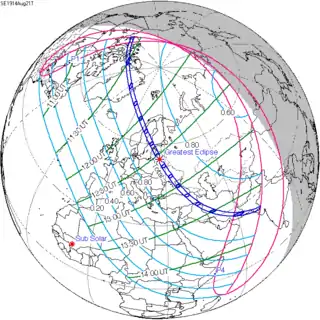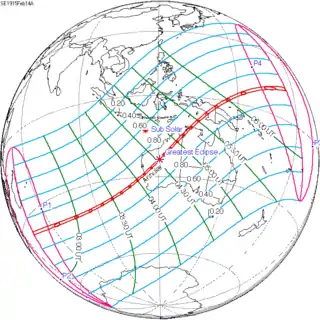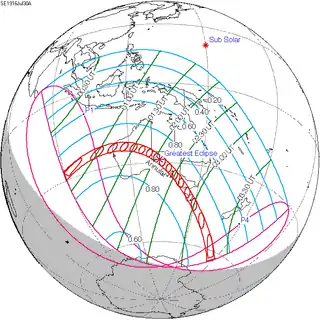Solar eclipse of July 19, 1917
A partial solar eclipse occurred on July 19, 1917. A solar eclipse occurs when the Moon passes between Earth and the Sun, thereby totally or partly obscuring the image of the Sun for a viewer on Earth. A partial solar eclipse occurs in the polar regions of the Earth when the center of the Moon's shadow misses the Earth.
| Solar eclipse of July 19, 1917 | |
|---|---|
 Map | |
| Type of eclipse | |
| Nature | Partial |
| Gamma | -1.5101 |
| Magnitude | 0.0863 |
| Maximum eclipse | |
| Coordinates | 63.7°S 101.8°E |
| Times (UTC) | |
| Greatest eclipse | 2:42:42 |
| References | |
| Saros | 154 (1 of 71) |
| Catalog # (SE5000) | 9321 |
Related eclipses
Solar eclipses of 1913–1917
This eclipse is a member of a semester series. An eclipse in a semester series of solar eclipses repeats approximately every 177 days and 4 hours (a semester) at alternating nodes of the Moon's orbit.[1]
| Solar eclipse series sets from 1913–1917 | ||||
|---|---|---|---|---|
| Descending node | Ascending node | |||
| 114 | August 31, 1913 Partial |
119 | February 25, 1914 Annular | |
| 124 | August 21, 1914 Total |
129 | February 14, 1915 Annular | |
| 134 | August 10, 1915 Annular |
139 | February 3, 1916 Total | |
| 144 | July 30, 1916 Annular |
149 | January 23, 1917 Partial | |
| 154 | July 19, 1917 Partial | |||
References
- van Gent, R.H. "Solar- and Lunar-Eclipse Predictions from Antiquity to the Present". A Catalogue of Eclipse Cycles. Utrecht University. Retrieved 6 October 2018.
External links
- Earth visibility chart and eclipse statistics Eclipse Predictions by Fred Espenak, NASA/GSFC
This article is issued from Wikipedia. The text is licensed under Creative Commons - Attribution - Sharealike. Additional terms may apply for the media files.
.jpg.webp)

